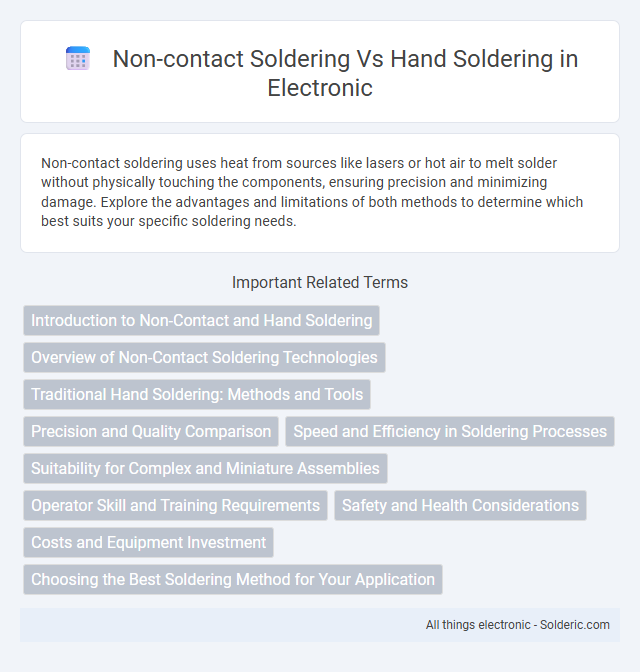Non-contact soldering uses heat from sources like lasers or hot air to melt solder without physically touching the components, ensuring precision and minimizing damage. Explore the advantages and limitations of both methods to determine which best suits your specific soldering needs.
Comparison Table
| Aspect | Non-contact Soldering | Hand Soldering |
|---|---|---|
| Method | Uses heat sources like infrared or hot air without physical contact. | Direct contact with a soldering iron tip. |
| Precision | High precision with controlled heat application. | Depends on operator skill, moderate precision. |
| Speed | Faster for repetitive tasks or mass production. | Slower, suitable for small volume or repair. |
| Heat Control | Consistent and adjustable temperature settings. | Manual control, less consistent heat. |
| Risk of Damage | Lower risk due to no physical contact and controlled heat. | Higher risk of pad lift or component damage. |
| Cost | Higher initial equipment cost. | Lower initial cost, minimal equipment. |
| Applications | Precision electronics, surface mount technology (SMT). | Prototyping, repair, basic through-hole components. |
Introduction to Non-Contact and Hand Soldering
Non-contact soldering uses techniques like hot air or laser to melt solder without physically touching components, reducing mechanical stress and improving precision for delicate electronics. Hand soldering relies on a soldering iron to manually apply heat to components and solder, offering greater control and flexibility for repairs or small-scale projects. Your choice between these methods depends on factors like component sensitivity, production volume, and skill level required.
Overview of Non-Contact Soldering Technologies
Non-contact soldering technologies include laser soldering, hot air soldering, and induction soldering, which use focused energy beams or heated gases to melt solder without direct tool-to-joint contact. These methods enhance precision, reduce mechanical stress on components, and minimize contamination risks in electronics manufacturing. Non-contact soldering is ideal for intricate PCB assemblies and sensitive materials where traditional hand soldering may cause damage or inconsistencies.
Traditional Hand Soldering: Methods and Tools
Traditional hand soldering involves using a soldering iron or soldering gun to manually join electronic components on a circuit board, requiring steady hands and precision. Tools commonly include solder wire, flux, soldering irons with temperature control, and desoldering pumps or braid for rework. You can achieve strong, reliable electrical connections with this method, especially for delicate or customized projects where non-contact soldering methods may not be feasible.
Precision and Quality Comparison
Non-contact soldering offers higher precision and consistent quality due to controlled heat application and reduced thermal stress, minimizing the risk of component damage and solder bridging. Hand soldering relies heavily on the operator's skill, making it prone to variations in joint quality and potential defects such as cold joints or uneven solder distribution. Your choice between these methods should consider the demand for repeatable accuracy and reliability in delicate or high-volume electronic assemblies.
Speed and Efficiency in Soldering Processes
Non-contact soldering offers significantly faster processing times by eliminating the need for manual heat application, which enhances overall efficiency in high-volume production environments. Hand soldering, while precise for small-scale or delicate tasks, is slower and more labor-intensive, impacting throughput and consistency. Your choice between these methods will directly influence manufacturing speed and operational efficiency depending on the scale and complexity of your soldering needs.
Suitability for Complex and Miniature Assemblies
Non-contact soldering techniques, such as laser or hot gas soldering, offer precise control and minimal thermal stress, making them highly suitable for complex and miniature assemblies where delicate components require accurate heat application. Hand soldering provides flexibility and tactile feedback, which is advantageous for small-scale repairs or prototypes but may lack the consistency and precision needed for intricate multi-component layouts. For high-density circuit boards and microelectronics, non-contact soldering enhances reliability by reducing the risk of component displacement and thermal damage.
Operator Skill and Training Requirements
Non-contact soldering requires less operator skill compared to hand soldering, as the process is largely automated and controlled by precise equipment settings, minimizing human error. Hand soldering demands extensive training and steady manual dexterity to ensure accurate placement and temperature control, making operator expertise critical for consistent quality. Your choice between these methods will impact training time and skill development necessary for optimal soldering performance.
Safety and Health Considerations
Non-contact soldering minimizes exposure to harmful fumes and reduces the risk of burns, enhancing operator safety by eliminating direct interaction with the heated element. This method often incorporates advanced ventilation systems, improving air quality in the workspace compared to traditional hand soldering. Hand soldering carries higher risks of repetitive strain injuries and accidental contact with hot tools, necessitating strict adherence to safety protocols and personal protective equipment to mitigate health hazards.
Costs and Equipment Investment
Non-contact soldering typically requires higher initial equipment investment due to advanced technology like laser or induction systems, leading to increased upfront costs compared to traditional hand soldering. Hand soldering demands minimal equipment such as soldering irons and basic tools, making it more cost-effective for small-scale or low-volume projects. Your choice between the two methods should consider both the budget for equipment and the scale of production to optimize long-term costs.
Choosing the Best Soldering Method for Your Application
Non-contact soldering offers precise heat control and reduces the risk of component damage, ideal for delicate or high-density electronic assemblies. Hand soldering provides flexibility and quick adjustments, making it suitable for prototyping and small production runs where manual skill enhances quality. Choosing the best soldering method for your application depends on factors like production volume, component sensitivity, and the need for repeatability or customization.
Non-contact soldering vs hand soldering Infographic

 solderic.com
solderic.com